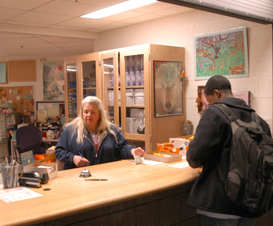|
    
Services
Fee Schedule for Mass Spectrometry Samples
Nominal mass scan:
$14 for UM shortcode accounts.
$30 for non-UM accounts.
High resolution exact mass measurements (includes a low resolution, nominal mass scan):
$18 for UM shortcode accounts.
$40 for non-UM accounts.
Access fees for students who wish to run their own samples:
MALDI-TOF:
$19/hr for UM shortcode accounts.
$65 for non-UM accounts.
LCT Electrospray-TOF:
$23/hr for UM shortcode accounts.
$65/hr for non-UM accounts.
GCMS:
$9/hr for UM shortcode accounts.
$65/hr for non-UM accounts.
The following mass spectrometry techniques are available:
Electrospray (ESI).
Electrospray can be used on relatively polar molecules over a wide massrange. It can be used on small molecules in the range from 100-1500 molecularweight, as well as larger molecules such as peptides and proteins. Largermolecules, such as proteins, will exhibit multiply charged ions byelectrospray, which can then be transformed to obtain the original molecularweight. Electrospray can be done in both positive ion and negative ion modes.In positive ion mode, neutral molecules will often exhibit an [M+H]+ion if run from an acidic solution. If cations such as Na+ arepresent in the solution, neutral molecules will often exhibit an [M+Na]+ion. Exact mass measurements within 5 ppm can be done on small molecules in themass range from 300 to 1500 daltons. Samples may be submitted for analysis, orstudents may be trained to run their own samples on the LCT instrument.
Matrix-Assisted, Laser-Desorption, Time-of-Flight (MALDI-TOF).
MALDI can be used on large molecules, such as peptides, proteins, andpolymers. Peptides will exhibit an [M+H]+ ion when run in positiveion mode. Samples can be submitted foranalysis, or students can be trained to use the instrument themselves.
Electron Impact Ionization (EI).
EI is good for small, stable compounds that readily go into the vapor phaseupon mild heating under vacuum. We can work with liquids, viscous oils, orsolids. We normally put the compound into a glass capillary vial, and insertthe vial into the end of a sample probe. For volatile liquids, we can freezethe sample in the vial using liquid nitrogen, and cool the probe tip to 0 C.For non-volatile solids, the probe tip can be heated as high as 350 C ifnecessary. For really non-volatile or thermally unstable compounds, we can usea thermal-desorption (DCI) probe tip. EI can be done in both nominal mass andexact mass modes. The nominal mass mode consists of a wide range magnetic scanusing an external calibration. It is generally accurate to within + or 0.4dalton. The exact mass mode consists of a linear voltage scan with internalreferences, and is generally accurate to within 5 ppm for compounds whosemolecular weight is less than 1000 daltons.
Chemical Ionization with ammonia (CI).
CI is used on those compounds that do not exhibit a molecular ion by EI. CIwith ammonia will often produce an [M+H]+ or an [M+NH4]+ion, depending upon the compound. We can use both the standard glass capillaryprobe, and also the DCI desorption probe. CI can be done in both nominal massand exact mass modes.
Fast Atom Bombardment (FAB).
FAB is useful for larger molecules (400 to 2000 daltons) that may bethermally unstable or non-volatile. It is also useful for ionic compounds, suchas organometallic salts. The sample must be soluble in order to work by FAB.The sample is usually dissolved in a suitable solvent, and then added to amatrix material on a target. We most often use 3-nitrobenzyl alcohol as amatrix. The target is then bombarded with a xenon atom beam, in order to causedesorption of ions. For neutral organic compounds we most often see an [M+H]+ion or an [M+Na]+ ion. We can often do an exact mass measurements byFAB on positive ions that are less than 1000 daltons. Nominal mass FAB willgenerally work on compounds as high as 2000 daltons.
Air-Sensitive compounds by EI.
We can work with compounds that are extremely oxygen and/or moisturesensitive, by using a special apparatus. The chemical sample can be put into aglass capillary vial in a drybox, and then placed into the air-tight apparatus.The air-tight apparatus is then brought out of the drybox to the massspectrometer. A helium atmosphere is used to push the sample into the probe,and helium gas shields the sample from air until it can be inserted into themass spectrometer and pumped down under vacuum.
Gas samples.
We have a variable-leak probe for introducing gas samples into the massspectrometer. The gas container must have a piece of OD diameter tubingto connect to the gas sampling probe. The gas samples we analyze must notcontain large amounts of oxygen, otherwise the oxygen will cause the filamentin the ion source to burn out.
|


